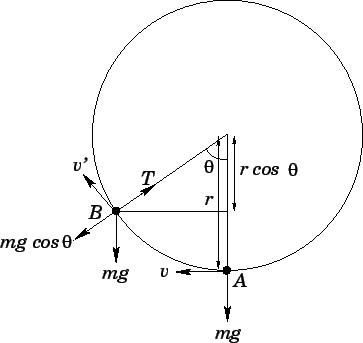 |
Consider Fig. 64. Suppose that the object moves from point ![]() , where its tangential
velocity is
, where its tangential
velocity is ![]() , to
point
, to
point ![]() , where its tangential velocity is
, where its tangential velocity is ![]() . Let us, first of all, obtain the relationship
between
. Let us, first of all, obtain the relationship
between ![]() and
and ![]() . This is most easily achieved by considering energy conservation.
At point
. This is most easily achieved by considering energy conservation.
At point ![]() , the object is situated a vertical distance
, the object is situated a vertical distance ![]() below the pivot, whereas at point
below the pivot, whereas at point ![]() the
vertical distance below the pivot has been reduced to
the
vertical distance below the pivot has been reduced to ![]() . Hence, in moving
from
. Hence, in moving
from ![]() to
to ![]() the object gains potential energy
the object gains potential energy
![]() . This gain
in potential energy must be offset by a corresponding loss in kinetic energy. Thus,
. This gain
in potential energy must be offset by a corresponding loss in kinetic energy. Thus,
| (290) |
Let us now examine the radial acceleration of the object at point ![]() . The radial forces
acting on the object are the tension
. The radial forces
acting on the object are the tension ![]() in the rod, or string, which acts towards
the centre of the circle, and the component
in the rod, or string, which acts towards
the centre of the circle, and the component
![]() of the object's weight,
which acts away from the centre of the circle. Since the object is executing
circular motion with instantaneous tangential velocity
of the object's weight,
which acts away from the centre of the circle. Since the object is executing
circular motion with instantaneous tangential velocity ![]() , it must experience
an instantaneous acceleration
, it must experience
an instantaneous acceleration ![]() towards the centre of the circle. Hence,
Newton's second law of motion yields
towards the centre of the circle. Hence,
Newton's second law of motion yields
Suppose that the object is, in fact, attached to the end of a piece of string, rather than a
rigid rod. One important property of strings is that, unlike rigid rods, they cannot
support negative tensions. In other words, a string can only pull objects attached to its
two ends together--it cannot push them apart. Another way of putting this is that if the
tension in a string ever becomes negative then the string will become slack and collapse.
Clearly, if our object is to execute a full vertical circle then then tension ![]() in the
string must
remain positive for all values of
in the
string must
remain positive for all values of ![]() . It is clear from Eq. (293) that the
tension attains its minimum value when
. It is clear from Eq. (293) that the
tension attains its minimum value when
![]() (at which point
(at which point ![]() ). This
is hardly surprising, since
). This
is hardly surprising, since
![]() corresponds to the point at which the
object attains its maximum height, and, therefore, its minimum tangential velocity. It is certainly
the case that if the string tension is positive at this point then it must be positive
at all other points. Now, the tension at
corresponds to the point at which the
object attains its maximum height, and, therefore, its minimum tangential velocity. It is certainly
the case that if the string tension is positive at this point then it must be positive
at all other points. Now, the tension at
![]() is given by
is given by
| (294) |
Suppose that the object is attached to the end of a rigid rod, instead of a
piece of string. There is now no constraint on the tension, since a rigid rod can
quite easily support a negative tension (i.e., it can push, as well as pull, on objects
attached to its two ends).
However, in order for the object to execute a complete vertical circle the square of its
tangential velocity ![]() must remain positive at all values of
must remain positive at all values of ![]() .
It is clear from Eq. (291) that
.
It is clear from Eq. (291) that
![]() attains its minimum value when
attains its minimum value when
![]() . This
is, again, hardly surprising. Thus, if
. This
is, again, hardly surprising. Thus, if ![]() is positive at this point then it must be positive
at all other points. Now, the expression for
is positive at this point then it must be positive
at all other points. Now, the expression for ![]() at
at
![]() is
is
| (296) |
| (297) |